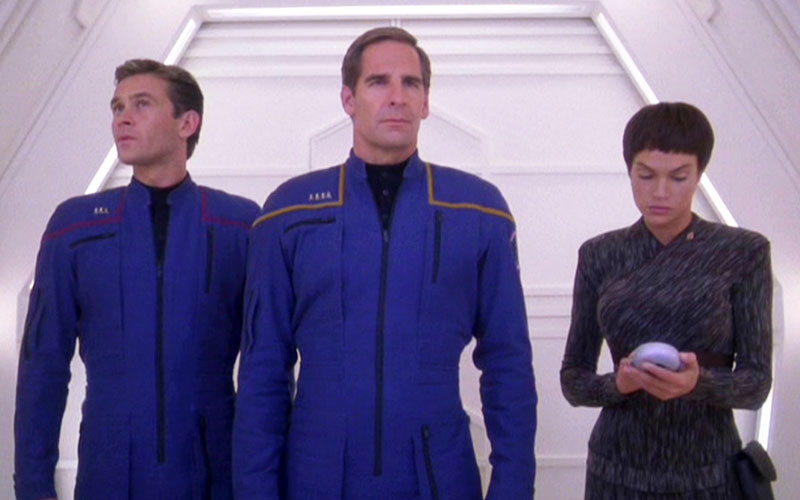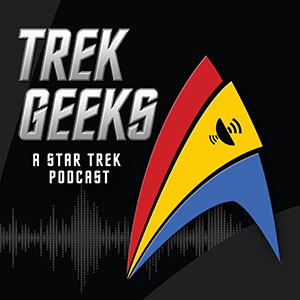I’m an American who has lived in London for almost a decade. Over the years, many people have asked me what I miss most about the US. My answer used to be that aside from family and friends, I only missed three things: Golden Oreos, Five Guys, and Star Trek on Netflix.
Slowly, each of these things have (thankfully) come off my list. Golden Oreos started appearing on supermarket shelves, not one but three Five Guys have opened in London, and as of July 1st, every Star Trek series finally came to Netflix UK.
Over the last week, many of my favorite blogs have published pieces about which episodes to watch. Rightly so, these articles all highlight the greatest hits: “City on the Edge of Tomorrow,” “Best of Both Worlds,” “In the Pale Moonlight,” etc. I admit to already watching “Year of Hell” and that “Yesterday’s Enterprise” is playing as I write this (“A Warrior’s Drink!”).
But I started thinking, now that I have more than 600 hours of Star Trek one Siri voice command away, what about the deep cuts? Those episodes that are TV but never make it onto anyone’s Top Ten list. After thinking long and hard about what some of my deep cuts were, I came up with the following five, one from each live action series.
Star Trek
“The Cage”
“Is your blood red like ours? I’m gonna find out.” – Pike
Watching “The Cage” is like listening to an acoustic demo of one of your favorite songs. It’s not particularly good but it does show potential, a blueprint for greatness. Fans know the background story of this episode. This was the original Star Trek pilot created by Gene Roddenberry, and starring Jeffrey Hunter as Captain Christopher Pike of the Starship Enterprise. Like HBO with the original Game of Thrones pilot, the network liked the concept, saw potential, but disliked many elements. This lead to the unusual decision of pouring more money into development, reworking the show, and reshooting the pilot. Arguably, the second pilot, “Where No One Has Gone Before,” isn’t that much better, despite the fact that it does establish Captain Kirk and co.
Like every Trek incarnation, “The Cage” is a product of its time, and it’s definitely a window into the attitudes of the sixties. Most famously, the episode had a female first officer – Number One, played by eventual Trek royalty, Majel Barrett. The studio noted that having a woman with that high a rank on a military vessel was unrealistic; Pike actually says the line “it’s just that I can’t get used to having a woman on the bridge.” It took Trek 25 years for it to have a female first officer (Deep Space Nine’s Major Kira) and almost 30 for its first female lead (Voyager’s Captain Janeway). But I digress, from both a behind-the-scenes perspective and a look at the original raw materials that would eventually become this 50-year long franchise, “The Cage,” makes for a fascinating watch.
Star Trek: The Next Generation
“The Wounded”
“It’s not you I hate, Cardassian. I hate what I became because of you.” – O’Brien
This episode is a watershed moment when it comes to Trek world building. “The Wounded” not only introduces us to the Cardassians (and to Nebula class starships) but it‘s the first episode to put Chief O’Brien front and center (it’s easy to imagine how this episode served as a backdoor audition for Miles to be bumped up to series regular; Colm Meany is amazing in this). “The Wounded,” along with Season Five’s “Ensign Ro,” laid the foundation on which Deep Space Nine was built on.
The episode is also one of the finest examples of Next Generation successfully tackling social issues (another would be “The Chain of Command,” which also owes much to “The Wounded.”). In this case, racism and PTSD. More specifically, the racism directed at one’s enemies of war. Chief O’Brien, and his old CO, Captain Maxwell, are both deeply scarred and haunted by their experiences and their actions during the Federation/Cardassian war. While Maxwell decides to go all Colonel Kurtz – TNG Executive Producer, Jeri Taylor has talked about the influence “Heart of Darkness” had on this episode – O’Brien, with the support of his wife and crew, eventually recognizes right from wrong and acts in a way that while morally correct, does not betray his respect and love for his old Captain. A complex and layered episode, one sprinkled with rousing Picard speeches, “The Wounded” is TNG at its best.
Star Trek: Deep Space Nine
“The Ascent”
“Well, that’s fine with me…’cause I hate you, too.” – Odo
From a failed pilot and a “Heart of Darkness” homage, to an episode that owes much to Laurel & Hardy (and maybe even to buddy comedies from the 80s). “The Ascent” is a love letter to fans of the Quark/Odo dynamic. Not only is this episode the culmination of four seasons worth of insults and shrugs between our protagonists but it’s also a showcase of Armin Shimerman and Rene Auberjonois’s wonderful comedic talents. Deep Space Nine – my very favorite of Treks – could do gothic, moody, and morally ambiguous better than anyone but it also knew how to put a smile on the faces of its fans for 45 minutes straight. “The Ascent,” along with episodes like “Our Man Bashir” and “Little Green Men,” showed the wonderful chemistry between the DS9 actors and their outer-space counterparts.
In addition, this episode includes a fun and relatable B-Story of what happens between you and your closest friends/family when you return home from your first year of college. The now uptight cadet Nog returning from Starfleet Academy and the messy and unfocused Jake Sisko have some great scenes together; scenes that – like the Quark/Odo A story – work because we’ve seen their relationship evolve over years. Arguably, the DS9 writers knew their audience best and when they decided to give in to fan service, man did they do it right.
Star Trek: Voyager
“Death Wish”
“What have you done Q?” – Q
Full disclosure, Voyager has never been my favorite. While the premise of the show was fantastic – and it did have the very best pilot of any series so far – the characters just never connected with me. With the exception of Janeway, the Doctor, and Seven, Voyager’s crew were just one-dimensional; I knew and cared more about supporting DS9 players like Rom or Martok than I ever did for the likes of Kes or Harry Kim. With that noted, Voyager produced some amazing episodes. The aforementioned “Year of Hell” and “Caretaker,” episodes like “Equinox,” are all among Trek’s greatest hits. For me “Death Wish” is not only a fantastic Voyager episode, it’s among my top 20 episodes ever. It’s poignant, interesting, and has my favorite version of John de Lancie’s Q – this is the Q of “Encounter at Farpoint” and “Tapestry,” irreverent and menacing.
“Death Wish” is ultimately about assisted suicide. More specifically what right society has to impose its will on an individual who, in deep pain, has made the decision to end their life. In classic Trek fashion, this episode successfully tackles a hot societal topic head-on, includes a trial in order to allow the judicial process to help resolve the issue at hand, and has the Captain make some great, long-winded speeches. “Death Wish” is a must-watch – even for this Voyager skeptic.
Star Trek: Enterprise
“Dead Stop”
“We’ve answered enough calls for help over the past year – it’s time someone returned the favor.” – Archer
Historically, Trek has never been great at horror or creepiness (I’m looking at you “Night Terrors”). “Dead Stop” is among the exceptions. This episode achieves an eerie Twilight Zone vibe rarely seen in Trek – props must go to Voyager’s Roxann Dawson, who directed this, along with nine other, episodes of Enterprise (she also directed the amazing “The Andorian Incident”).
“Dead Stop” is a direct continuation of the previous episode’s storyline, a rarity at this point in Enterprise’s run. It features a vulnerable crew and starship; it starts with the Enterprise sending out a distress signal as opposed to responding to one. A seemingly sentient repair station responds and the Enterprise is lured into a slowly unfolding trap. After the ship manages to destroy the station, and the crew realizes the extent of what’s happened, the episode ends with an awesome and silent shot of the station starting to repair itself – getting ready for its next victims. “Dead Stop” is nothing short of pulpy sci-fi fun, the type of episode that successfully recalls the 60s roots of the franchise and other sci-fi classics like “2001: A Space Odyssey.”
There you have it folks: five of my Trek deep cuts. What did you think? Should I have included “Up the Long Ladder” or “If Wishes Were Horses?” I look forward to seeing your comments below and to the day when Siri can recognize me asking her to play “Inter Arma Enim Silent Leges.”



























![2023: A banner year for Star Trek — here’s why [Op-Ed]](https://treknews.net/wp-content/uploads/2024/01/star-trek-2023-year-in-review-600x337.jpg)












![[REVIEW] STAR TREK: SHORT TREKS "Children of Mars": All Hands... Battlestations](https://treknews.net/wp-content/uploads/2020/01/review-star-trek-short-treks-children-of-mars.jpg)
































Akiva1
July 6, 2016 at 1:13 pm
You seem to focus on the trivial regarding “The Cage” and miss its message. Regarding 60’s attitudes, this pilot was considered too cerebral for TV – and even today is far better intellectually than the crap we see on free and pay TV. Its successor, “Where No Man Has Gone Before,” talks about what it means to be a God! And that was in 1966! To say it “wasn’t much better” belies your lack of television history and what true science fiction really is.
Zarm
July 6, 2016 at 4:21 pm
The ‘too cerebral’ bit is urban legend, actually. It was considered a bit slow-paced, but primarily it was considered too *risque* for TV (the Orion slave girl scene, as well as the general ‘find a mating partner and start a new race’ plotline), and the network didn’t have confidence in all of the cast members to headline a series. Yes, there was more of a focus on action-adventure (which Roddenberry himself pushed for, too; he was a TV producer, and knew what made popular television), but that was a minor consideration and not why The Cage was turned down.
It’s just that Roddenberry’s the one that became famous, and history is written by the victors, so he spun it to make the network men look like neanderthals. (“Make us think too much! Girl on bridge and not barefoot in kitchen! No good! More fighting and men next time!”) 🙂
Dunleavy
July 6, 2016 at 3:46 pm
TOS: “Who Mourns for Adonais?”. TNG: “First Contact”. DS9: “The Visitor”. VOY: “Blink of an Eye”. ENT: “Through a Mirror, Darkly”.
Kevin
July 6, 2016 at 7:22 pm
This list needs DS9’s “In The Pale Moonlight”. Now that was an episode with some major oomph behind it. Loved it from start to finish.
saurabh
July 7, 2016 at 12:31 am
i think the writer was talking about episodes that dont make the top ten of any particular show. ‘In The Pale Moonlight’ will always be my number one episode of DS9.
saurabh
July 7, 2016 at 12:32 am
Thank you for pointing out that DS9 is available on Netflix!! Happy days……
Philbury
July 8, 2016 at 4:02 am
Time to give up your day job, Carlos. Your future as TV critic awaits!
Muldfeld
October 14, 2016 at 1:59 am
I feel sorry for people who think TNG’s better than DS9 — and I hate them.